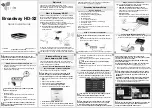
`
This document contains Iridium Satellite LLC Proprietary Information may which may not be used, reproduced, or
disclosed without written approval from Iridium Satellite LLC.
IR3142-ICD-006 Issue 1 v2.1
Page 8 of 16
EXT_PWR accepts input voltages of +12 VDC +/- 2.5 V with an input ripple less than 40 mV peak-
to-peak. The maximum operational input current for the Iridium Certus 9770 in stable operation is
1.5 A.
Note: For safety compliance the external power source should meet requirements of IEC 62368-
1 classes ES1 & PS2.
3
RF Interface
The Iridium Certus 9770 has a dedicated RF connector that provides a connection to an external
passive antenna.
3.1
RF Connector Type
The Iridium Certus 9770 has a right-angle jack, MMCX 50-ohm RF connector (Samtec part
number MMCX-J-P-H-RA-TH1). The RF connector is located on the opposite end of the
transceiver from the digital connector.
3.2
General RF Specifications
The general RF interface requirements for the Iridium Certus 9770 are summarized in Table 3.2-1
below. All radiated values assume a compliant antenna and cable system (see Reference 4).
Parameter
Value
Frequency Range
1616 MHz to 1626.5 MHz
Transmit Frequency Range
1616 MHz to 1626 MHz
Receive Frequency Range
1616 MHz to 1626.5 MHz
Duplexing Method
TDMA (Time Division Multiple Access)
Input / Output Impedance
50
Ω
Modulation
QPSK, DEQPSK
Maximum Average EIRP
9 dBW
Maximum Peak EIRP
15 dBW
Transmit RF Burst Duration
8.2 ms
Table 3.2-1: General RF Parameters
3.3
Conducted RF Outputs
The Iridium Certus 9770 RF output power at its connector varies during normal operating
conditions as it is subject to dynamic transmitter power control by the Iridium
®
network. As such,
the conducted RF power average (measured at the RF connector) across the burst may range
b24 dBm and +40 dBm, depending on the signal type, link conditions and dynamic power

































